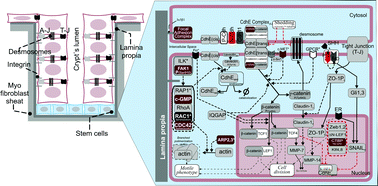Analysis of cell adhesion during early stages of colon cancer based on an extended multi-valued logic approach†
Abstract
Cell adhesion in the normal colon is typically associated with differentiated cells, whereas in cancerous colon it is associated with advanced tumors. For advanced tumors growing evidence supports the existence of stem-like cells that have originated from transdifferentiation. Because stem cells can also be transformed in their own niche, at the base of the Lieberkühn's crypts, we conjectured that cell adhesion can also be critical in early tumorigenesis. To assess this hypothesis we built an annotated, multi-valued logic model addressing cell adhesion of normal and tumorigenic stem cells in the human colon. The model accounts for (i) events involving intercellular adhesion structures, (ii) interactions involving cytoskeleton-related structures, (iii) compartmental distribution of α/β/γ/δ-catenins, and (iv) variations in critical cell adhesion regulators (e.g., ILK, FAK, IQGAP, SNAIL, Caveolin). We developed a method that can deal with graded multiple inhibitions, something which is not possible with conventional logical approaches. The model comprises 315 species (including 26 genes), interconnected by 269 reactions. Simulations of the model covered six scenarios, which considered two types of colonic cells (stem vs. differentiated cells), under three conditions (normal, stressed and tumor). Each condition results from the combination of 92 inputs. We compared our multi-valued logic approach with the conventional Boolean approach for one specific example and validated the predictions against published data. Our analysis suggests that stem cells in their niche synthesize high levels of cytoplasmatic E-cadherin and CdhEP(Ser684,686,692), even under normal-mitogenic stimulus or tumorigenic conditions. Under these conditions, E-cadherin would be incorporated into the plasmatic membrane, but only as a non-adhesive CdhE_β-catenin_IQGAP complex. Under stress conditions, however, this complex could be displaced, yielding adhesive CdhE_β-catenin(cis/trans) complexes. In the three scenarios tested with stem cells, desmosomes or tight junctions were not assembled. Other model predictions include expected levels of the nuclear complex β-catenin_TCF4 and the anti-apoptotic


 Please wait while we load your content...
Please wait while we load your content...